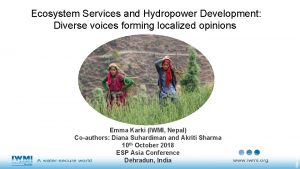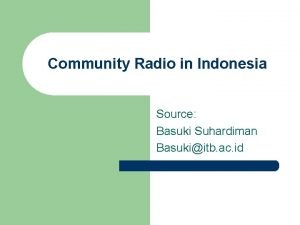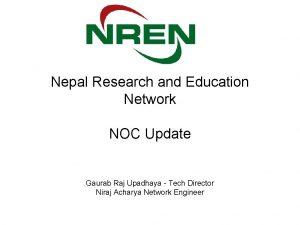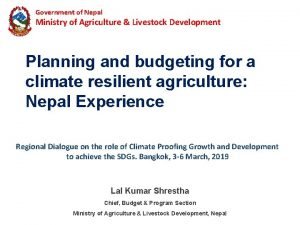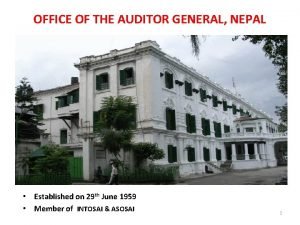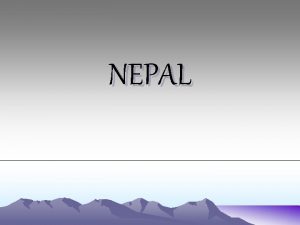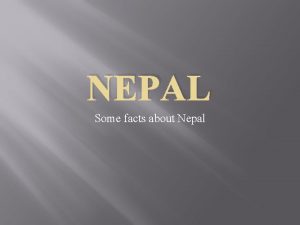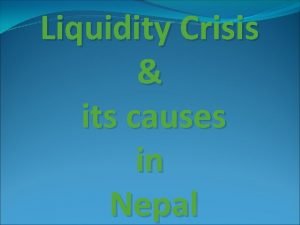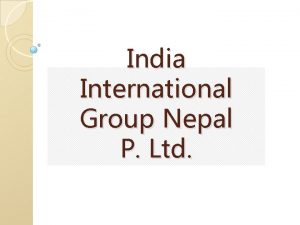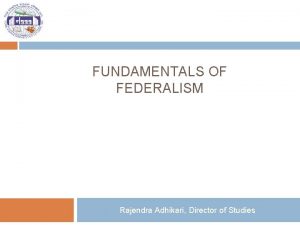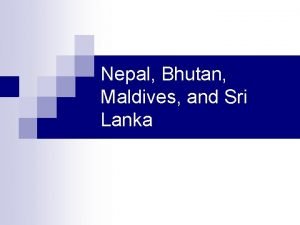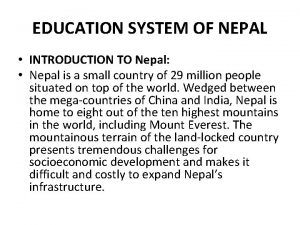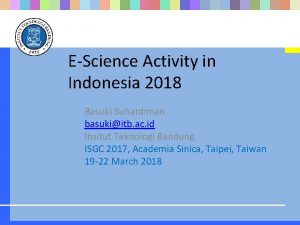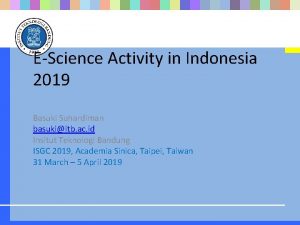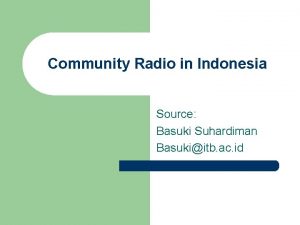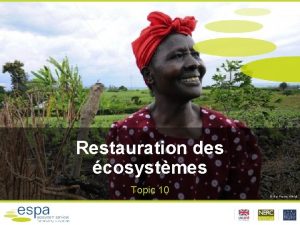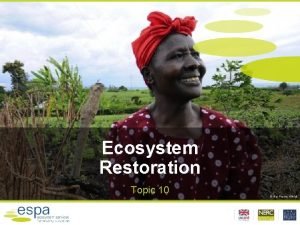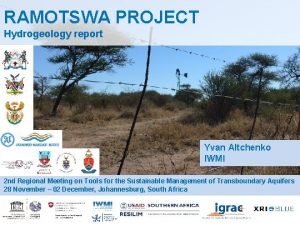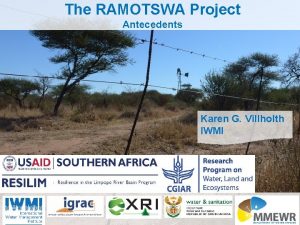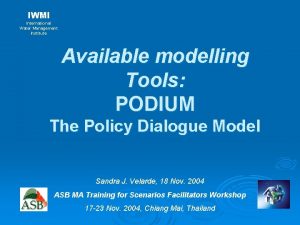Emma Karki IWMI Nepal Coauthors Diana Suhardiman and













- Slides: 13

Emma Karki (IWMI, Nepal) Co-authors: Diana Suhardiman and Akriti Sharma 10 th October 2018 ESP Asia Conference Dehradun, India Photo : Tom Cakenberghe/IWMI Photo: Davidvan Brazier/IWMI Photo: : David Brazier/IWMI Photo Ecosystem Services and Hydropower Development: Diverse voices forming localized opinions

INTRODUCTION Nepal has 6, 000 rivers that are fed by monsoonal rains Hydropower potential estimated at 43, 000 MW, only 2% tapped Pathway to promote socio-economic growth However, hydropower has faced resistance in Nepal Currently 56 projects in the pipeline to increase capacity from 986 MW to 20, 279 MW Key priority in the National Development Plans Concerns on social and environmental impacts and overall decision making process Relevant sectors working in silos

CURRENT POLICIES AND PRACTICES Developers are required to submit EIA No formal authority to track and monitor compliance EIA incorporates environment flow requirements Cultural eflow requirements not considered Release 10% minimum monthly average discharge Currently, developers are not even releasing 10%

METHODS • Part of the larger Digo Jal Bikas Project (Karnali and Mahakali) • In Depth Interviews with 24 national level stakeholders • In Depth Interviews with 5 UKCC members and 15 farmers in 8 affected villages along the Karnali • 260 social surveys conducted in the five districts in the Karnali Basin

CONTEXT - KARNALI RIVER • Underdeveloped region • Several large hydropower and irrigation projects planned and under construction • Lack of coordination amongst relevant sectors • Foreign investment in hydropower projects • Diverse priorities – Hydropower/Tourism/ Agriculture/Biodiversity

CURRENT ECOSYSTEM SERVICES Fishing communities are fully dependent on the river to sustain their livelihoods Forest clearance and private and government land acquisition puts keystone species at risk Source of irrigation and drinking water Religious and cultural uses (festivals, rituals) Tourism – White Water Rafting Home to the endangered Gangetic Dolphins, Golden Mahseer, and critically endangered Gharial Riparian communities feel a sense of happiness to hear the river flowing

THE CASE OF THE UPPER KARNALI • 900 MW hydropower project, USD 1. 15 billion • 426 households affected, 56 to be resettled • Developed by GMR – an Indian company • Mo. U singed in 2008 • PDA signed in 2014 • Plan to export electricity to Bangladesh • Current phase: Financial closure, land acquisition

BENEFIT SHARING 27% free equity to Go. N Questions regarding who benefits and how? 2 MW Rural Electricity 12% total Royalty to affected area 108 MW free electricity to Nepal 3000 Direct Employment Infrastructure, Local shares, Resource utilisation Most importantly, who decides?

DIVERSE VOICES Upstream Downstream Agriculture and Fishing Land compensation Employment Biodiversity Loss Tourism

“Our villages have never seen development; the government has not developed our area. Finally, we have some jobs coming and now the so-called experts want to stop that as well. ” - Thalpatta village Upstream Views “The most important thing is that I can now use the money from the land compensation payment to invest in my son’s education to be land surveyor and works and earns money from the company later. Hence, I am willing to take the risk”. Sisne village “I do not think that the planned hydropower project would benefit villagers. Even when we would get free access to electricity, this would not benefit us if it means we have to lose everything else related to our farming activities. ” – Saura village Downstream Views “When the planned dam would force us to stop fishing, we do not know as to whether we would be able to make the needed transition in our livelihood options, as we lack the skills needed for that. ” – Ramaghat village

ASSESSMENT FRAMEWORK FOR ECOSYSTEM SERVICES • Agriculture, hydropower, tourism, biodiversity and socio-cultural uses – many endangered and critically endangered species • In the midst of large scale hydropower and irrigation canal construction – Vulnerable state anticipating future scenario • Need to contextualise the framework since the upstream and downstream communities have different demands • Hydropower will benefit local to regional communities – at what cost? • Irrigation will impact the overall food security of the country • Requires a multiscale assessment to ensure development does not lead to irreversible ES loss, extinction of endangered species

WAYS FORWARD Inclusion of local governing bodies in the negotiation process Regulatory framework for hydropower development practices at local level Incorporate socio-cultural e-flow requirements in EIA Government body to monitor compliance by hydropower developers, authority to penalise Coordination amongst various government bodies to assess impact on other sectoral projects

RELEVANT LINKS • • Suhardiman D. , Bastakoti R. , Karki E. , Bharati L. (2018). The politics of river basin planning and state transformation processes in Nepal. Geoforum, 96: 70 -76. Suhardiman, D. , Karki, E. , Bastakoti, R. Putting power and politics central in Nepal’s water governance. (forthcoming) Suhardiman, D. and Karki, E. Spatial Politics and Local Alliances Shaping Nepal Hydropower (forthcoming) Karki E. , Suhardiman D. , Drown P. , Swingle C. (2018). The importance of local voices in Nepal’s hydropower projects. The Thirdpole, Wednesday, 8 TH August, 2018. Available online at: https: //www. thethirdpole. net/en/2018/08/08/the-importance-of-local-voices-in-nepals-hypropower-projects/ Sharma A. , Claire S. (2018). Balancing people and energy in the Karnali Basin. The Thirdpole, 20 TH August, 2018. Available online at: https: //www. thethirdpole. net/en/2018/08/20/balancing-people-and-power-in-thekarnali-basin/ Dhaubanjar S. , Drown P, Karki E. (2017). What’s a river worth? The Kathmandu Post, 15 TH December, 2017. Available online at: http: //kathmandupost. ekantipur. com/printedition/news/2017 -12 -15/whats-a-river-worth. html Suhardiman D. (2017). River basin planning: An imaginary bureaucratic territory. Blog. Sustainable Water Future Programme (http: //water-future. org/blog/river-basin-planning/). Thank you! Questions?
 Emma karki
Emma karki Basuki suhardiman
Basuki suhardiman Edad de diana alvarez del diario de diana
Edad de diana alvarez del diario de diana Chapter 25 section 3 nepal and bhutan
Chapter 25 section 3 nepal and bhutan Nepal research and education network
Nepal research and education network Ministry of agriculture and livestock development
Ministry of agriculture and livestock development Auditor general nepal
Auditor general nepal Zastava nepala
Zastava nepala Where is napal
Where is napal Ymca nepal
Ymca nepal Causes of liquidity crisis in nepal
Causes of liquidity crisis in nepal Iig nepal
Iig nepal Banjaran kapuas hulu
Banjaran kapuas hulu Why was federal system felt necessary in nepal
Why was federal system felt necessary in nepal
